The global interest and development in Small Modular Reactors (SMRs) are experiencing a significant surge, with numerous countries actively integrating this technology into their energy strategies. This expansion is driven by increasing electricity demand, energy security imperatives, and national goals to reduce carbon emissions, positioning SMRs as a key component of future clean energy landscapes.
Key Takeaways
- Global SMR deployment is expanding rapidly, with 74 designs analyzed and 51 in licensing processes across 15 countries.
- The International Atomic Energy Agency (IAEA) predicts nuclear capacity could more than double by 2050, with SMRs playing a pivotal role.
- Southeast Asia is heavily investing in SMRs as part of a substantial nuclear power expansion plan.
Global Expansion and Progress in SMR Development
The Nuclear Energy Agency’s (NEA) latest SMR Dashboard reveals a significant increase in SMR activity worldwide. Currently, 74 SMR designs are under analysis, with 51 undergoing pre-licensing or licensing procedures in 15 countries. Approximately 85 active discussions are underway between SMR developers and potential site owners globally. The report also highlights progress in supply chain readiness and financing, noting an 81% increase in SMR designs securing funding commitments since the previous edition.
Seven SMR designs are already operating or under construction, indicating a strong pipeline for first-of-a-kind deployments. The diversity of designs offers a wide range of options for customers, though it also presents challenges for regulators and the industrial supply chain. Opportunities exist to streamline global supply chains, promote standardization, and enhance the economic viability of SMRs.
IAEA’s Optimistic Outlook for Nuclear Power
The International Atomic Energy Agency (IAEA) has consistently raised its forecasts for nuclear power, now predicting that global nuclear capacity could more than double by 2050. In its high-case scenario, nuclear capacity could increase from 377 GW in 2024 to nearly 992 GW by 2050. SMRs are expected to contribute significantly to this growth, potentially accounting for 24% of new capacity added by 2050 in the high-case projection.
This optimistic outlook is fueled by growing concerns about climate change, energy security, and the increasing demand for clean energy, particularly from data centers and expanding digital services. The IAEA emphasizes that nuclear energy is seen as essential for achieving clean, reliable, and sustainable electricity globally. Key drivers for this expansion include climate concerns, policy support, rising electricity demand, and financial backing from development banks, alongside the life extension of existing reactors.
Southeast Asia’s Strategic Bet on SMRs
Southeast Asia is making a significant commitment to nuclear power, with plans to invest approximately $208 billion to develop 25 GW of nuclear capacity by 2050, primarily utilizing SMRs. Despite higher initial costs, SMRs are favored for their quicker deployment and fewer regulatory hurdles compared to traditional large reactors. Vietnam aims to lead this development with plans for up to 14 GW, while countries like Malaysia, the Philippines, and Thailand are also exploring or planning SMR deployments.
IAEA’s Initiative to Boost SMR Knowledge
The IAEA is actively expanding its global initiatives to enhance understanding and facilitate informed decision-making regarding SMRs. Through programs like the "SMR School," the agency is providing training and knowledge sharing for policymakers, regulators, and industry stakeholders across various regions, including Asia and Africa. These workshops cover technical, regulatory, economic, and infrastructure aspects of SMR development and deployment, aiming to build a strong foundation for nuclear energy adoption in line with international safety standards.
Sources
- Nuclear Energy Agency (NEA) – New NEA Small Modular Reactor Dashboard edition reveals global expansion of SMR
deployment, Nuclear Energy Agency (NEA). - Southeast Asia bets on small modular reactors in $208B nuclear plan, Latest news from Azerbaijan.
- IAEA Predicts Doubling Nuclear Capacity by 2050—SMRs and Reactor Life Extensions Lead the Way • Carbon
Credits, CarbonCredits.com. - IAEA Says Nuclear Capacity Could More Than Double By 2050, With SMRs Playing ‘Pivotal Role’, NucNet.
- IAEA Expands Global Initiative to Boost Knowledge of SMRs, IAEA.












